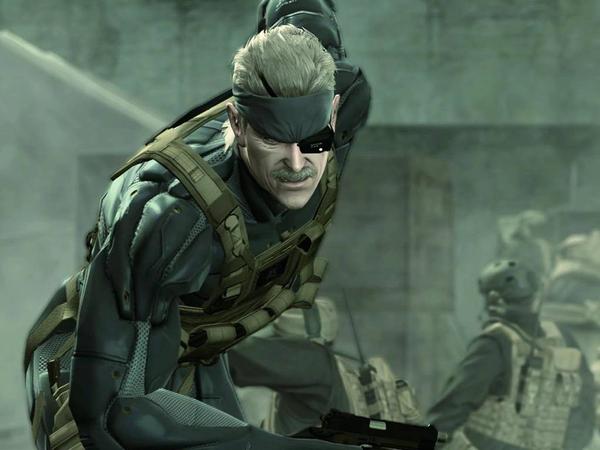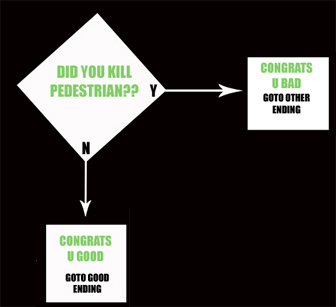Software development isn’t an easy gig. On top of shifting requirements, dwindling budgets, meddling publishers, and rapidly changing tools, it’s a miracle that so many terrific games come out every year. We live in a game renaissance. BioWare is our Medici family.
That being said, most games are still lousy. And they’re lousy in very specific, easily-fixable ways. Between storytelling problems, design flaws, and all the miserable tropes that get copy-pasted into each new release, designers tend to fall into the same traps over and over. With the caveat that these problems aren’t always applicable – nobody expects a coherent story out of Marvel vs. Capcom 3, or the next Metal Gear, for that matter – here are some of the problems we have with games, and how we think they can be fixed. Let the grousing begin!

1. Action Climax Overload. Don’t make every other moment of your game an action climax.
There’s a sequence near the end of Rockstar’s Red Dead Redemption that defines hero John Marston as a character. Because it’s so unique, it also helps illustrate what’s wrong with the way games tell stories. After spending several gory weeks stabbing bears and hog-tying gangsters, Marston settles down into life as a rancher. Most games would use this final act to ratchet up the body count with power suits, ultimate weapons, or exploding rogue nukes, but Redemption has you shooing crows away from your granary and herding cattle. This lengthy pause from the action isn’t just a buffer zone, either; it serves a simple and clear narrative purpose, one that makes Redemption’s ending that much more poignant.

The following statement is just as applicable to games as it is to movies: When every moment is an action climax, then no moment is an action climax. Tentpole shooters like Gears of War, Medal of Honor, and the Calls of Duty balance out action sequences by letting you skulk in the shadows with a silenced pistol, or by throwing you into a helicopter… that always crashes. Stealth and vehicle sections may dilute monotony, but they’re just as predictable and numbing as gunfights. Intensity is important, but every bullet fired yields diminishing returns.
How do you fix it?
Not every game can pull off a ranch act, but the climax overload problem has multiple solutions. For one, let us interact with your gameworld. If your main character is part of a team, give us a hub where we can talk to them, or review our accomplishments and prepare for the next round. BioWare understands this better than most developers – the moments on the ship in Mass Effect 2 and in Dragon Age: Origin’s camp are among their games’ most memorable. More importantly, they make returning to the action something to look forward to.
Another way: if your game’s protagonist goes it alone, then give us a safe place to explore between setpieces. Uncharted 2’s Himalayan village, where Nathan Drake explores a town filled with people, livestock, and kids playing soccer, is one example.
There are exceptions to the rule. Twitch-oriented multiplayer games and arcade titles don’t need to worry about sensory overload. For games interested in cultivating atmosphere and story, though, it’s an important lesson to learn.
2. Show me, don’t tell me. Better yet, let me figure it out on my own.
It’s not a stretch to say that most big titles are bursting at the seams with cutscenes and cinematic interrupts. Killzone 3 was intentionally trumpeted by its developer for having over 70 minutes of cutscenes. Final Fantasy XIII was a cutscene even when it wasn’t. Also, Metal Gear 4 is something that exists. Cutscenes can be rewarding if they’re done right, but they’re mostly just stale exposition pellets that bring immersion to a screeching halt.

Cutscenes are like long text crawls in movies – they’re lazy, and they don’t take advantage of what makes games a special medium. Instead of telling us a story, games are in the unique position to let us experience them. Valve understands this. The Half Life series never shifts focus from Gordon Freeman, offering a narrative experience without ever tearing control away from the player. It trusts the player to experience its story without intervention, making it more than just another shooting gallery with occasional movie clips.
How do you fix it?
If you can’t trust your story enough to let it evolve naturally out of your gameplay, then ditch your story. A half-baked narrative littered with clichés and exposition won’t make your game any better, and might even make a potentially good arcade title worse.
If people should take games seriously as artistic endeavors, then games should start acting like a serious artistic endeavors. Or at the very least, stop behaving like crappy ones.
3. Don’t be afraid of punishing the player. Stress can be rewarding.
American games reward success. Japanese games punish failure. – Reappropriated Simpsons Proverb
Games are gussied-up reward systems. The rewards might be bragging rights, a new plot point, or something as simple as a trophy or achievement. At the most elemental level, they’re what keep us engaged. It’s fun to pick apart how some of the more successful and addictive games combine rewards to greater effect.
But what about the role punishment plays within these reward systems? Is punishment necessary to a game experience, or is it detrimental? We’d argue that it’s necessary. Poorly designed punishment systems can be a disaster, but an effective punishment system can make a good game even more rewarding.
Unfortunately, most games these days treat the possibility of failure as something to be avoided, or at least minimized at all costs. 2006’s Prey has a unique but very limited punishment system. Every time the player character dies, he’s thrust into a resurrection minigame that lets him pop back into the fray right where he left off. This auto-resurrect feature might be clever, but it ensures that there’s never much at stake. Some of the boss fights are challenging, but so what? If you’re killed, you respawn. Had the game been more punishing, the battles would’ve been inherently stressful – and the game would have been more engaging.
Fable II and III provide even better examples, as it’s impossible to die during a playthrough. If Fable were just a Fantasy dog-ownership sim, this would be fine, but it isn’t; Fable II presents a decades-long revenge story that culminates in a showdown requiring nothing but patience to reach. Since there’s no stressor, there’s no conflict, rendering every quest dramatically inert. Luckily, there were other reasons to play Fable II, like collecting property or shitting your pants. Along with invincible heroes, there’s also the recurring trend of virtual co-op partners (Far Cry 2, Prince of Persia) who can instantly resurrect your character.

Listen: nobody wants another Battletoads. The value of strict punishment systems is arguable, but there clearly needs to be a balance. Detractors of 2006’s Dead Rising complained that save points were far too sparse, and that a single save slot was a design flaw rather than a carefully planned punishment device. Even 2009’s Demon’s Souls, which punished players in some severe and creative ways, wasn’t for everyone. Some people see little value in punishment systems, while others view it as a critical part of the experience. One thing is certain: if there’s no punishment in failure, then there’s no real accomplishment to be won, either.
How do you fix it?
You can’t fix this by ramping up difficulty and making enemies stronger. Giving God of War 3’s Zeus a billion more hit points would make things excruciating, not exciting. Instead, we’d like to see more games take risks with strategic gameplay. When there are multiple ways to solve a puzzle, kill an enemy, or defend a command point, failure becomes an opportunity to try something new.
4. This puzzle shouldn’t be here. Why am I moving floor tiles again I just want to shoot some rowbutts
Puzzles and minigames are the perfect counterpoints to busy setpieces or firefights. In theory. When was the last time a puzzle left you feeling exhilarated and eager for the next one?
The problem isn’t the puzzles themselves, but lazy puzzle design – more specifically, it’s that developers copy and paste the same universal puzzle templates into a game, sometimes multiple times. If you find yourself shifting floor tiles, aligning mirrors, or moving pedestals into sinking platforms, you’re likely playing through one developer’s lazy attempt to vary pace and break up action sequences. Instead of varying pace, this kills immersion. Going from a frenzied gunfight into a switch-flipping puzzle designed for Dark Forces 2: Jedi Knight instantly reminds you that you’re playing a game.
How do you fix it?
If you can’t design an original puzzle and would feel guilty stealing from Portal, then try varying pace in a different way. See item number 1.
5. Unlikely karma systems and the illusion of choice. Surely there’s a middle ground somewhere.
The year is 20XX. You’re a rogue galactic templar, and you’ve just stumbled upon a crippled United Territory transport ship carrying expensive omni-goop and a hold filled with starving Martian refugees. Do you:
1) Fix the ship, give them all your credits, and donate your kidney in case a Martian refugee needs it at some point.
2) Kill the crew, steal the goop, sell the Martians as slaves, and destroy the ship. For style, fill an escape pod with the contents of your personal septic tank and eject it into the debris field as a calling card.
Q: What if my space-racist templar loves the United Territory, but hates Martians? Why not meet me halfway?
A: Don’t worry about it. The outcome of this decision is totally irrelevant to the story.

Games love trotting out the illusion of choice. Much like the above scenario, inFamous’ Cole MacGrath spends most of the game choosing between two unlikely karmic extremes. The “choices” let you play as either a guileless do-gooder or Mad Men‘s Pete Campbell, and since these divergent paths determine the abilities your character develops, you’re punished for not taking sides. None of these choices affect the story. Even the otherwise stellar Mass Effect 2 turns dozens of player decisions from 60+ hours worth of gameplay into little more than cutscene variations and dialogue callbacks. If you’re giving us choices that don’t matter, what’s the point?
How do you fix it?
If you’re implementing a karma system without embedding it into the story, then at least give us a range of options and rewards for playing the game the way we want to. For example, Fallout 3 offers a perk that rewards players for remaining karmically neutral. For those who insist that a game with palpable, far-reaching consequences just isn’t possible, check out the underrated Alpha Protocol.
If we love our games, then it’s a tough love. We hear a lot of “Take our hobby seriously!” from the internet, but there’s never much acknowledgment of the core, systemic problems that plague so many games. Will fixing these problems magically turn games into art? Of course not – but it will make them a lot more fun to play.
Agree? Disagree? Do chime in below with your thoughts.